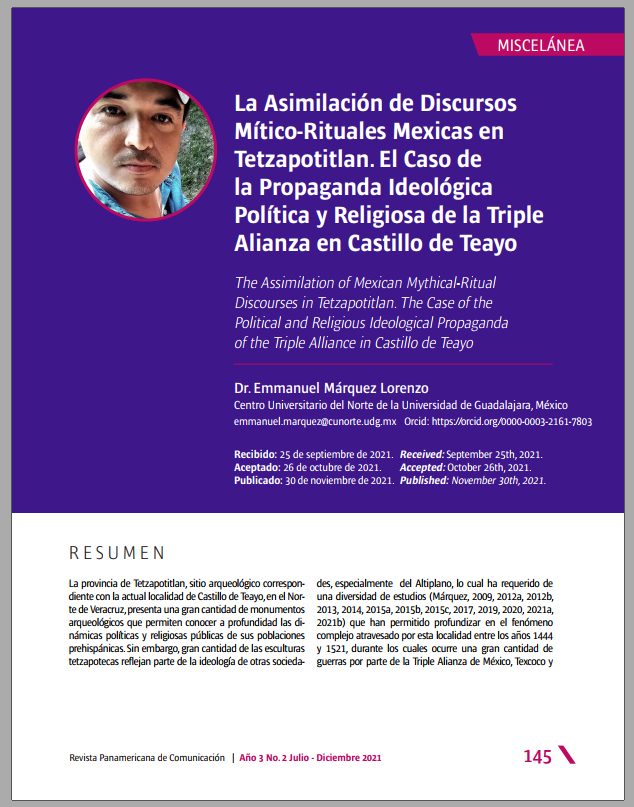La Asimilación de Discursos Mítico-Rituales Mexicas en Tetzapotitlan. El Caso de la Propaganda Ideológica Política y Religiosa de la Triple Alianza en Castillo de Teayo
Contenido principal del artículo
Resumen
La provincia de Tetzapotitlan, sitio arqueológico correspondiente con la actual localidad de Castillo de Teayo, en el Norte de Veracruz, presenta una gran cantidad de monumentos arqueológicos que permiten conocer a profundidad las dinámicas políticas y religiosas públicas de sus poblaciones prehispánicas. Sin embargo, gran cantidad de las esculturas tetzapotecas reflejan parte de la ideología de otras sociedades, especialmente del Altiplano, lo cual ha requerido de una diversidad de estudios (Márquez, 2009, 2012a, 2012b, 2013, 2014, 2015a, 2015b, 2015c, 2017, 2019, 2020, 2021a, 2021b) que han permitido profundizar en el fenómeno complejo atravesado por esta localidad entre los años 1444 y 1521, durante los cuales ocurre una gran cantidad de guerras por parte de la Triple Alianza de México, Texcoco y Tlacopan. Estas acciones militares ocasionaron la sujeción definitiva de Tetzapotitlan en 1480, pero también el despoblamiento, esclavización y matanza de varones nativos de la localidad en México Tenochtitlan en 1487. A partir de este año, los discursos oficiales tetzapotecas se modificaron profundamente, debido a la presencia de una nueva población con un bagaje cultural en apariencia distinto, como se observa en las representaciones escultóricas, pero en esencia similar, de ahí que su culto haya sido asimilado (en honor de la tierra, la lluvia y el maíz). El poder político y religioso expresado propagandísticamente en las celebraciones y festividades orilló a los tetzapotecas a aceptar estos cambios culturales, y eso explica, a su vez, el por qué de la existencia de tales esculturas.
Detalles del artículo
Sección

Esta obra está bajo una licencia internacional Creative Commons Atribución-NoComercial-SinDerivadas 4.0.
Cómo citar
Referencias
Márquez Lorenzo, Emmanuel (2021a). Tetzapotitlan-Teayo. Precisiones Toponímicas en la Huaxteca Meridional. Revista Pueblos y Fronteras Digital, (16), 1-27. http://www.pueblosyfronteras.unam.mx/index.php/index.php/pyf/article/view/503/1076.
Márquez Lorenzo, Emmanuel (2021b). Relaciones Políticas entre Grupos Nahuas y Tének en el Epiclásico y Posclásico de Mesoamérica. Revista Española de Antropología Americana, (51), 33-57. https://revistas.ucm.es/index.php/REAA/article/view/66245/4564456558210.
Márquez Lorenzo, Emmanuel (2020). Estética y Poder en Castillo de Teayo: Las Representaciones Mexicas y sus Implicaciones Sociales. En Niklas Schulze, Miguel Nicolás Caretta y Beckett Lailson (coords.), Expresiones Materiales del Poder en el Contexto Arqueológico del México Prehispánico. (pp. 133-159). México, Universidad Autónoma de San Luis Potosí-Bornholms Museum-El Colegio de Michoacán A. C. http://sociales.uaslp.mx/Documents/Publicaciones/Libros/ExpresionesMateriales.pdf.
Márquez Lorenzo, Emmanuel (2019). Tetzapotitlan: The Toponym of the Preterite Society of Castillo de Teayo. Journal of Historical Archaeology and Anthropological Sciences, 4(1), 26-31. https://medcraveonline.com/medcrave.org/index.php/JHAAS/article/view/12849
Márquez Lorenzo, Emmanuel (2017). El Dominio Mexica de Tetzapotitlan. El Ejercicio del Poder y sus Repercusiones Ideológicas. Xalapa, Edición del autor.
Márquez Lorenzo, Emmanuel (2015a). La Conformación Militarista de la Sociedad Mexica. En Terrones Calvario, Martín, Joel Solís Pérez, Jorge Ramírez López y Guadalupe Angelina Salazar Vázquez (Coords.), Memoria del 1/er. Congreso Nacional de Historia Militar de México, a través de los Archivos Históricos. Tomo I. (pp. 157-174). México, Secretaría de la Defensa Nacional. http://www.sedena.gob.mx/pdf/1er_congreso/Tomo_I.pdf.
Márquez Lorenzo, Emmanuel (2015b). Evidencias de imposición de cultos mexicas en Tetzapotitlan. Tesis de Doctorado en Arqueología. México, Escuela Nacional de Antropología e Historia. https://www.academia.edu/42008682/Evidencias_de_Imposici%C3%B3n_de_Cultos_Mexicas_en_Tetzapotitlan
Márquez Lorenzo, Emmanuel (2015c). Arqueología de Castillo de Teayo, en Viaje Por La Ciencia, editado por Manuel Martínez Morales y José Manuel Velasco Toro, pp. 145-149. Xalapa, Secretaría de Educación de Veracruz-Consejo Veracruzano de Investigación Científica y Desarrollo Tecnológico-Consejo Nacional de Ciencia y Tecnología. https://www.academia.edu/41966185/Arqueolog%-C3%ADa_de_Castillo_de_Teayo.
Márquez Lorenzo, Emmanuel (2014). Arqueología de Castillo de Teayo. La Ciencia y el Hombre, XXVII(1), 62-65. https://www.uv.mx/cienciahombre/revistae/vol27num1/articulos/arqueologia-castillo-teayo.html.
Márquez Lorenzo, Emmanuel (2013). Estética y poder en Castillo de Teayo: las representaciones mexicas y sus implicaciones sociales (1480-1521 d.C.). En Héctor M. Medina Miranda, Anuschka van´t Hooft, Patricia Julio Miranda y Ángel B. Espina Barrio (Coords.), Estética, Cultura y Poder: Convergencias bajo un Enfoque Transdisciplinario. (pp. 482-496). San Luis Potosí, Instituto de Investigaciones Antropológicas de Castilla y León-Facultad de Ciencias Sociales-Universidad de Salamanca.
Márquez Lorenzo, Emmanuel (2012a). El análisis del monumento 4 de Castillo de Teayo y la correlación de calendarios: xiuhpohualli, tonalpohualli, toxiuh molpilia y romano. Cuicuilco, 19(53), 97-135. http://www.scielo.org.mx/scielo.php?script=sci_arttext&pid=S0185-16592012000100005
Márquez Lorenzo, Emmanuel (2012b). Aspectos teóricos y metodológicos para el análisis de las representaciones de Tláloc y Chicomecóatl en Tetzapotitlan (Castillo de Teayo). Tesis de Maestría en Arqueología. México, Escuela Nacional de Antropología e Historia. http://mediateca.inah.gob.mx/repositorio/islandora/object/tesis%3A572
Márquez Lorenzo, Emmanuel (2009). La ‘Piedra del Maíz’ de Castillo de Teayo. La imposición de cultos como estrategia de dominación ideológica de la Triple Alianza. Tesis de Licenciatura en Arqueología. Xalapa, Facultad de Antropología de la Universidad Veracruzana. https://www.academia.edu/49970070/La_Piedra_del_Ma%C3%ADz_de_Castillo_de_Teayo_La_Imposici%C3%B3n_de_Cultos_como_Estrategia_de_Dominaci%-C3%B3n_Ideol%C3%B3gica_de_la_Triple_Alianza

